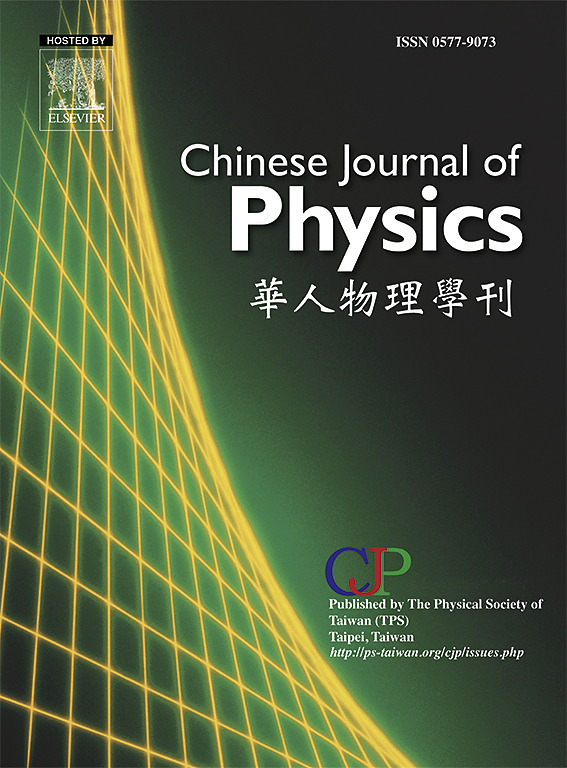Blowing and multiple slip effects on bio-nano-convection flow in porous media within the gap of a rotating cone-disc system
IF 4.6
2区 物理与天体物理
Q1 PHYSICS, MULTIDISCIPLINARY
引用次数: 0
Abstract
Fluid flow inside the gap between a rotating cone and a disc has significant applications in bio-chemical engineering, biotechnological (biofuel) processing and materials science. In these areas, engineers are continuously exploring the combination of nanofluids, bioconvection mechanisms and other features (e.g. porous filtration materials) to optimize (flow) performance. Motivated by these applications, the present article describes a mathematical model for simulating nanofluid transport with bioconvection micro-organisms inside the conical gap between a rotating cone-disc system containing an incompressible, sparse Darcian porous medium. Buongiorno's two-component nanoscale model is deployed for the nanofluid and Kuznetsov gyrotactic bioconvection model utilized for the micro-organism self-propulsion. The mathematical model also features multiple walls slip effects and Stefan blowing boundary conditions. By employing coordinate transformations derived via group theory methods, the governing transport equations are transformed into a set of similarity equations with coupled boundary conditions. These transformed similarity equations are then solved numerically with an efficient finite difference method available in the MATLAB solver “bvp4c”. Some of the results reported are verified with special cases from the literature. Extensive graphical visualization of the key flow characteristics is included. Four physical cases are considered, namely the static disc with rotating cone, static cone with rotating disc, disc-cone in co-rotation, and disc-cone in counter rotation. Smaller gap angles are observed to intensify heat, NPVF transport rates and wall motile microorganism flux rates. Axial velocity attains the highest magnitude with large centrifugal force generated by the rotation of cone. Thermal slip induces a decrement in fluid temperature and associated thermal boundary layer thickness. Greater Stefan blowing leads to an increment in velocity components, fluid temperature, nanoparticle concentration (volume fraction) and gyrotactic microorganism concentration (density number) for all 4 cases examined.

吹气和多滑移效应对多孔介质中生物纳米对流的影响
在生物化学工程、生物技术(生物燃料)加工和材料科学中,流体在旋转锥与圆盘间隙内的流动具有重要的应用。在这些领域,工程师们不断探索纳米流体、生物对流机制和其他特性(如多孔过滤材料)的结合,以优化(流动)性能。受这些应用的启发,本文描述了一个数学模型,用于模拟生物对流微生物在包含不可压缩、稀疏的达西安多孔介质的旋转锥盘系统之间的锥形间隙内的纳米流体传输。纳米流体采用了Buongiorno双组分纳米尺度模型,微生物自推进采用了Kuznetsov陀螺仪生物对流模型。数学模型还考虑了多壁滑移效应和Stefan吹风边界条件。利用群论方法导出的坐标变换,将控制输运方程转化为一组边界条件耦合的相似方程。然后用MATLAB求解器“bvp4c”中有效的有限差分法对这些变换后的相似方程进行数值求解。报告的一些结果用文献中的特殊病例进行了验证。广泛的图形可视化的关键流动特性包括在内。考虑了静盘带转锥、静锥带转盘、盘锥共转、盘锥反转四种物理情况。观察到较小的间隙角可以增强热量,NPVF输运率和壁面移动微生物通量率。当锥体旋转产生较大的离心力时,轴向速度达到最大。热滑移引起流体温度和相关热边界层厚度的衰减。在所有4例病例中,较大的斯特凡吹气导致速度分量、流体温度、纳米颗粒浓度(体积分数)和回旋微生物浓度(密度数)的增加。
本文章由计算机程序翻译,如有差异,请以英文原文为准。
求助全文
约1分钟内获得全文
求助全文
来源期刊

Chinese Journal of Physics
物理-物理:综合
CiteScore
8.50
自引率
10.00%
发文量
361
审稿时长
44 days
期刊介绍:
The Chinese Journal of Physics publishes important advances in various branches in physics, including statistical and biophysical physics, condensed matter physics, atomic/molecular physics, optics, particle physics and nuclear physics.
The editors welcome manuscripts on:
-General Physics: Statistical and Quantum Mechanics, etc.-
Gravitation and Astrophysics-
Elementary Particles and Fields-
Nuclear Physics-
Atomic, Molecular, and Optical Physics-
Quantum Information and Quantum Computation-
Fluid Dynamics, Nonlinear Dynamics, Chaos, and Complex Networks-
Plasma and Beam Physics-
Condensed Matter: Structure, etc.-
Condensed Matter: Electronic Properties, etc.-
Polymer, Soft Matter, Biological, and Interdisciplinary Physics.
CJP publishes regular research papers, feature articles and review papers.
 求助内容:
求助内容: 应助结果提醒方式:
应助结果提醒方式:


